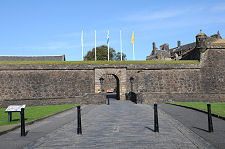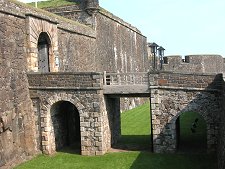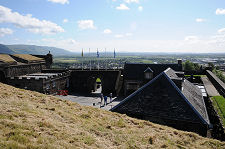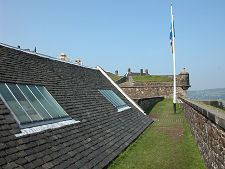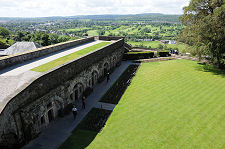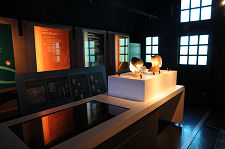 Front Wall and Outer Ditch |
The great defensive Forework built at Stirling Castle by James IV was magnificent, but in purely military terms it was already out of date by the time of its construction in 1501-1506. Within 50 years it was becoming clear that the castle needed defences better suited to the increasing power of the artillery of the time.
The defences you can see today are the product of two main phases of upgrading. The first of these was ordered by Mary de Guise in 1559. Mary was widow of James V, mother of Mary Queen of Scots, and Regent of Scotland. She used Stirling Castle as her main residence and needed something fit for an age in which English and French armies equipped with modern artillery fought for control of Scotland: and in which Stirling was the key to that control. See our Stirling Castle Timeline for more about the castle during this period, or our Historical Timeline for the wider picture.
Mary constructed a line of defences across the neck of the castle rock a little distance in front of James IV's Forework. Parts of this are still visible despite extensive later work. The most important surviving element is what is today called the French Spur. This is an artillery spur projecting from the eastern end of the defences and capable of firing to the east and south as well as also along the line of the main front wall of the castle. (Continues below image...)
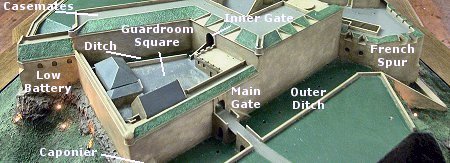 The Outer Defences Shown on the Castle Model in the North Gate |
Parts of the front wall between the French Spur and the entrance date back to Mary de Guise's improvements. Instead of today's entrance, however, there was a large angled stone construction called a talus designed to deflect cannon balls, and a road leading around to a gate a little to the west.
The next and most recent round of improvements to the frontal defences at Stirling Castle date back to work that took place between 1711 and 1714 in response to the threat posed by the Jacobites.
The French Spur remained, but was modified to allow cannons on two levels to fire along the length of a much larger main ditch protecting a single frontal wall running the full width of the defences. Within the ditch were placed two caponiers, low level firing galleries designed to ensure life was made unpleasant, and short, for attackers in the ditch. Only the caponier at the west end of the ditch remains, and it can be accessed via some interesting stairs from the Guardhouse Square.
The main entrance is reached across a raised roadway over the ditch, which for much of its life included a drawbridge. This brings you into the Guardhouse Square. When built this contained a guardhouse, a stable, and a hay store. The hay store now houses a shop and the ticket office, but otherwise it looks much as it would in 1714.
Any attackers making it as far as the Guardhouse Square were far from home and dry. It is overlooked by higher defensive walls to the northwest and northeast, and a further ditch protects the main wall. Entrance to the castle from the Guardhouse Square was across a stone bridge over the ditch and through a heavily protected inner gate.
The improvements made by 1714 were not tested during the Jacobite uprising of 1715, but if they had been it is unlikely the castle would have proved easy prey. And when the Jacobites did take the town of Stirling in 1746 during the '45 uprising they did not tackle the castle frontally, choosing instead to try to bombard it from the lower hill to the east, with disastrous results for the attackers who found themselves outgunned by the defensive batteries, including the guns of the French Spur.
The final feature of the Outer Defences are the casemates. These are vaulted chambers set within the frontal walls and designed to provide heavily protected accommodation for the garrison when under artillery attack. Those on the west side overlooking the bowling green were single storey and are now used for displays about the castle's history. The casemates between the Guardhouse Square and the French Spur were originally two storey and have been converted into the Unicorn Cafe.
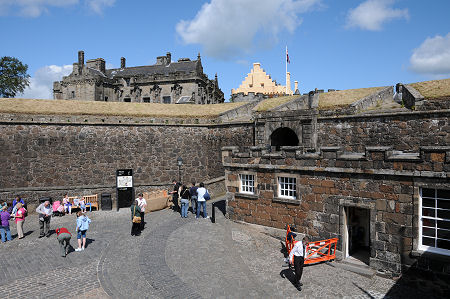 Guardroom Square |
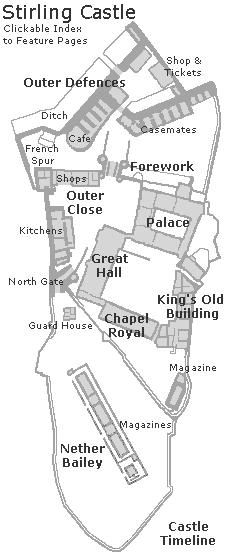
|
|
|
Visitor InformationView Location on MapFull information can be found on our Stirling Castle Main Page. What3Words Location: ///sums.joined.draw |
Stirling Castle In Fiction
|
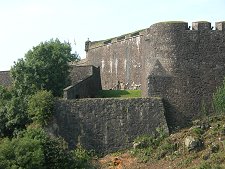 Outer Ditch from the East |
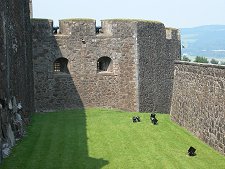 French Spur and Outer Ditch |
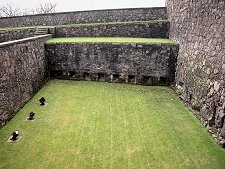 Caponier in the Outer Ditch |
 Caponier Interior |
 Hide and Seek by Ken Lussey (26 May 2023).
Hide and Seek by Ken Lussey (26 May 2023).